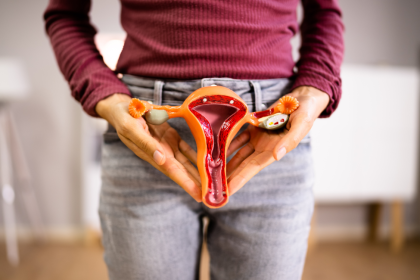The transition into menopause represents a profound shift in a woman’s life, bringing both challenges and opportunities. While often discussed in terms of what’s ending, menopause also marks the beginning of a new phase that can span a third of a woman’s life. During perimenopause, the transitional years leading up to menopause, and menopause itself, the body undergoes significant hormonal changes that can trigger symptoms ranging from mild to life-altering.
Approximately 85% of women experience noticeable symptoms during this transition. Hot flashes affect about 75% of perimenopausal women, while mood fluctuations, sleep disturbances and weight distribution changes are nearly as common. What many women don’t realize is that nutrition plays a crucial role in how the body navigates these changes, with research increasingly showing that dietary choices can significantly impact symptom intensity and overall wellbeing during this transition.
While hormone therapy remains an important treatment option for many, emerging research points to nutrition as a powerful complementary approach – and sometimes a first-line strategy – for managing menopause symptoms. Here are eight evidence-based nutritional strategies that can help women navigate this transition with greater ease and better health outcomes.
Phytoestrogen-rich foods
Plants contain compounds called phytoestrogens that can mimic the effects of estrogen in the body, though much more weakly than the body’s natural hormones. These plant-based compounds have received significant research attention for their potential to ease menopause symptoms, particularly hot flashes.
Soy foods contain high levels of isoflavones, the most studied type of phytoestrogen. Research published in the journal Menopause found that women consuming at least 54 mg of soy isoflavones daily experienced approximately 50% fewer hot flashes compared to control groups. This amount equates to roughly two servings of traditional soy foods like tofu, tempeh or edamame daily.
Flaxseeds represent another potent source of phytoestrogens, specifically lignans. A study in the Journal of the Society for Integrative Oncology found that consuming 40 grams of crushed flaxseed daily reduced hot flash frequency by up to 50% and severity by 57%. Other beneficial sources include chickpeas, lentils and whole grains, which can be incorporated into daily meals for cumulative benefits.
Omega-3 fatty acid focus
The dramatic hormonal shifts of menopause can increase inflammation throughout the body, contributing to joint pain, skin changes and mood disturbances. Omega-3 fatty acids help combat this inflammation while supporting brain health during a time when cognitive changes can be concerning.
Research from Harvard Medical School demonstrates that women with higher omega-3 intake report fewer hot flashes and less psychological distress during the menopausal transition. Cold-water fatty fish like salmon, mackerel and sardines provide the most bioavailable forms of these beneficial fats, with walnuts, chia seeds and flaxseeds offering plant-based alternatives.
For optimal benefits, nutrition researchers recommend consuming fatty fish at least twice weekly or taking a high-quality supplement providing 1,000-2,000 mg of combined EPA and DHA daily. Women already experiencing joint pain or significant mood changes may benefit from the higher end of this range, while others might maintain wellness with regular dietary sources.
Bone-building nutrient combinations
The accelerated bone loss that begins in perimenopause requires a proactive nutritional approach beyond just calcium. Research now emphasizes the importance of nutrient combinations that work synergistically to maintain bone density during this vulnerable period.
Calcium and vitamin D remain foundational, with studies from the National Institutes of Health confirming that adequate levels of both nutrients reduce fracture risk by up to 20%. However, newer research highlights the crucial roles of vitamin K2, magnesium and potassium in proper calcium utilization and bone matrix formation.
Dark leafy greens like kale and collards provide calcium along with magnesium and potassium. Fermented foods like natto contain exceptional levels of vitamin K2, while mushrooms exposed to sunlight offer vitamin D. A strategic approach involves consuming a variety of these foods daily, along with weight-bearing exercise, which enhances nutrient uptake into bone tissue.
Blood sugar stabilizing meals
Fluctuating estrogen levels during perimenopause can impact insulin sensitivity, making blood sugar management more challenging. This not only influences energy levels and mood but can also exacerbate hot flashes, which research suggests may be triggered by sudden blood sugar changes.
Studies published in the American Journal of Clinical Nutrition demonstrate that meals combining protein, healthy fats and fiber help maintain stable blood sugar levels throughout the day. This approach minimizes the insulin spikes that can trigger hot flashes and energy crashes common during the menopausal transition.
Practical implementation involves structuring meals to always include protein sources like eggs, fish or legumes, paired with fiber-rich vegetables and fruits, and rounded out with healthy fats from avocados, nuts or olive oil. This balanced approach helps prevent the mid-afternoon energy slumps that many women find particularly problematic during perimenopause and early menopause.
Mindful hydration practices
Dehydration can intensify many common menopause symptoms, from increased hot flash frequency to heightened anxiety and cognitive fog. The hormonal fluctuations of perimenopause can also alter fluid balance in sometimes unexpected ways.
Research from the University of Connecticut’s Human Performance Laboratory found that even mild dehydration, defined as 1-2% of body weight, negatively impacts mood, energy and cognitive function in women. For those already experiencing menopause-related cognitive changes sometimes called “brain fog,” proper hydration becomes even more crucial.
Most women transitioning through menopause benefit from consuming 2-3 liters of fluid daily, with an emphasis on water, herbal teas and water-rich foods. Those experiencing frequent hot flashes may need additional fluids to replace what’s lost through increased perspiration. Keeping track of hydration through smartphone apps or simply maintaining a water bottle throughout the day helps many women meet these increased needs.
Strategic caffeine and alcohol approach
Both caffeine and alcohol can trigger or intensify hot flashes, sleep disturbances and mood fluctuations during the menopausal transition, though sensitivity varies significantly among women. Research indicates that their effects become more pronounced during perimenopause due to changing hormone levels.
A study in the journal Menopause found that women who reduced caffeine intake experienced approximately 25% fewer hot flashes compared to those maintaining higher consumption. Similarly, research published in the Journal of Clinical Endocrinology & Metabolism demonstrated that even moderate alcohol consumption increased hot flash frequency and disrupted deep sleep phases crucial for mood regulation.
Rather than eliminating these substances entirely, many women benefit from a strategic approach. This might involve switching to half-caffeinated coffee in the morning only, choosing lower-alcohol wine options, or tracking symptoms in relation to consumption to identify personal thresholds. This individualized approach acknowledges the social and pleasure aspects of these beverages while minimizing negative impacts.
Gut health optimization
The gut microbiome plays a surprisingly central role in hormone metabolism and the management of menopause symptoms. Emerging research indicates that specific bacterial populations can influence how the body processes and eliminates hormones, potentially affecting symptom severity.
Studies from the University of Illinois show that women with more diverse gut microbiomes report fewer menopause-related symptoms overall. Specifically, bacteria that produce short-chain fatty acids appear to help regulate estrogen metabolism in ways that can minimize symptom fluctuations.
Practical approaches include regularly consuming fermented foods like yogurt, kefir and kimchi to introduce beneficial bacteria, while feeding these microbes with prebiotic-rich foods such as garlic, onions, leeks and asparagus. Reducing ultra-processed foods further supports microbiome health by eliminating ingredients that disrupt beneficial bacterial populations.
Anti-inflammatory spice integration
Chronic inflammation increases during menopause due to declining estrogen levels, potentially contributing to joint pain, cardiovascular concerns and even mood disorders. Certain culinary spices contain powerful anti-inflammatory compounds that can help counteract these effects.
Research published in BMC Complementary Medicine and Therapies demonstrated that women consuming turmeric regularly experienced reduced joint pain and improved mood measures compared to control groups. The active compound curcumin appears particularly beneficial, with studies showing it helps modulate the inflammatory response that intensifies during the menopausal transition.
Other beneficial spices include ginger, which research in the journal Complementary Therapies in Medicine linked to reduced hot flash severity, and cinnamon, which helps stabilize blood sugar fluctuations that can trigger various menopause symptoms. Incorporating a teaspoon of these spices into daily cooking or beverages provides the consistent intake needed for measurable benefits.
While every woman’s menopause journey is unique, nutrition provides a foundational approach that can help manage symptoms while supporting long-term health. These eight strategies offer evidence-based starting points that can be personalized based on symptom patterns, preferences and individual response.
Many women find that combining multiple approaches yields the greatest benefit, with effects building over time as the body adjusts. Working with healthcare providers knowledgeable about both menopause and nutrition can help tailor these strategies to individual needs, potentially reducing reliance on medications and enhancing quality of life during this significant transition.
Rather than viewing menopause simply as a time of loss, this nutritional approach recognizes it as a natural life phase that can be navigated with greater ease when supported by strategic dietary choices. By addressing the root causes of common symptoms through nutrition, women can often achieve more sustainable relief while simultaneously investing in their long-term health.
















